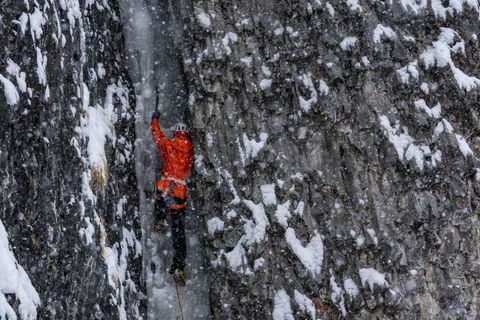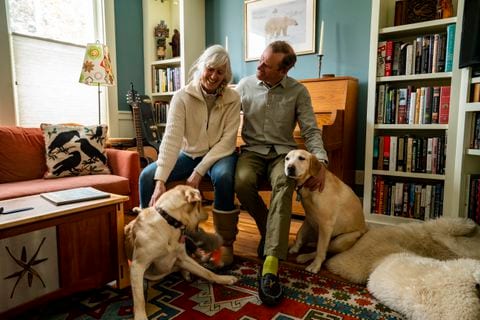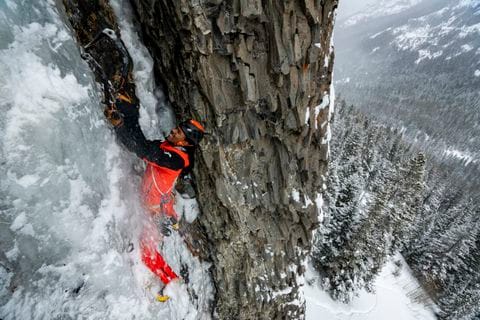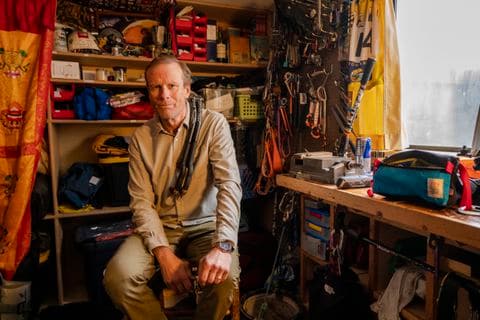Conrad Anker, aging patriarch of the world’s elite climbers, lowers his horizons
BOZEMAN, Mont. — Thousands of hours strapped to the side of miles-high mountains, freezing winds assaulting exposed skin, the sun reflecting almost blindingly off snow — it all shows on Conrad Anker’s face.
The lines there confirm his nearly 60 years, most of them lived as one of the world’s elite alpinists. Theirs is a profession with an infinitesimal margin for error: how high is too high, which slope is too steep, where to find the edge between adventure and foolishness, adoration and reproach, life and death.
The long list of friends Anker has lost to climbing grows every year, and their absence weighs heavy on him. He is the anomaly, the aging patriarch, who again and again has confronted a grim question: Why not me?
But not on this day, which he is spending in Hyalite Canyon barely a half-hour south of his home, chainsawing a storm-toppled pine tree to clear a trail. The canyon is a special place for him. Ancient geological oddities built it, and each winter water seeping from cliff walls freezes and creates a vertical playground of icefalls the color of Caribbean waters. Adventurers with picks, spiked boots and sufficient bravado come from all over, and they shower Anker with questions about avalanche conditions and requests for photos.
“Mayor of the ice slag,” he calls himself, a title Anker embraces while considering what’s next personally and for the sport that he loves. His many first-ever ascents, his discovery of British mountaineer George Mallory’s body during a trek up Everest, have brought international fame. Climbing is pitiless, though, and his exploits have come at a cost. Boldness can be viewed as arrogance in this sport, especially when things go wrong.
“We are born, and we struggle, and, in the end, gravity wins,” he says. “What we do in climbing is a way of respecting it.”
Nearly a decade ago in the Himalayas, Anker summited Everest without the aid of supplemental oxygen and then, with partners Jimmy Chin and Renan Ozturk, became the first to go up Meru via its “shark fin,” a spiteful slab seen as unclimbable.
“Part of all that is having a high pain threshold and knowing what your limits are and not going over that edge,” Anker explains. “It’s like licking honey off a razor. If you turn the axis the wrong way, you’re screwed.”
Anker calls Meru the culmination of all he had accomplished as an alpinist — a feat highlighted by a movie bearing the mountain’s name — and he realizes now that it should have been enough. “Instead,” he says, “I went out after more.”
 Conrad Anker has made three ascents of Everest and summited Meru in the Himalayas. But when he’s home in Montana, he heads to Hyalite Canyon for a bit of day climbing. (Jason Thompson/For The Washington Post)
Conrad Anker has made three ascents of Everest and summited Meru in the Himalayas. But when he’s home in Montana, he heads to Hyalite Canyon for a bit of day climbing. (Jason Thompson/For The Washington Post) That more was Lunag-Ri, among the tallest unclimbed peaks in Nepal. On his second attempt in 2016 with Austrian David Lama, his heart seized at 20,000 feet as he clung to the side of an ice-covered granite blade. How ironic, he thought. “Celebrated mountaineer felled by heart attack,” was not the headline he envisioned at the end of his life. Yet there he was.
Anker credits Lama for saving him, for helping him rappel down Lunag-Ri and coaxing him across a perilous ice field. The journey to emergency surgery took nine hours, and nine hours is a long time to reflect on mistakes and regret, even for an atheist like Anker. Mostly, he thought about his wife.
“I can’t believe I did this to Jenni,” he remembers thinking. “I can’t believe I made her a widow again.”
Jenni is Jennifer Lowe-Anker, and the “again” part can’t be ignored in any account about Anker. In 1999, he was with her husband, Alex Lowe, and another climber, David Bridges, when an avalanche swept Tibet’s Mount Shishapangma and killed both of those men. “I ran a different direction and walked away,” he says.
Anker returned to Bozeman, where he and Jenni bonded over their grief. Two years later, they married. A headline in Outside magazine summed up the situation around that time: “His friends are gone. His life is a soap opera. His career is in overdrive.”
Anker is still riled by the unsigned hate mail, accusing the couple of selfishness and irresponsibility, that regularly arrived during their early years. He helped raise the three boys of the man he calls “my brother from another mother,” and today those boys are men and call him dad. He and Jenni will celebrate their 20th anniversary next month.
Better than most, his wife understands all that comes with being married to a climber, both the glorious and dark sides to their risk-reward equations.
“We are all here for a moment in time,” she notes. “We are a blink. Well, what are you going to with your blink? Is it going to be meaningful to you? What is your responsibility to the Earth, to humanity, to the people in your life you love? We all get to make those choices.”
 Conrad Anker and Jenni Lowe-Anker married in 2001 after a climbing tragedy on the other side of the world brought them together in grief. (Jason Thompson/For The Washington Post)
Conrad Anker and Jenni Lowe-Anker married in 2001 after a climbing tragedy on the other side of the world brought them together in grief. (Jason Thompson/For The Washington Post) The spring before Anker’s heart attack, ice melted on Shishapangma, and the mountain finally gave up Lowe and Bridges. They were cremated there, their families present. Gravity eventually caught up with Lama, too. Three years after he saved Anker — and after going back and conquering Lunag-Ri solo — an avalanche killed him and two other climbers in the Canadian Rockies. He was 28.
The high-altitude ascents that landed Anker on magazine covers are no longer an option — a post-heart-attack concession to his wife and doctors. But he has twice been on expeditions to Antarctica, twice scaled El Capitan in Yosemite National Park and regularly assaults Hyalite’s experts-only pitches with a fleet of 20-somethings out to test themselves.
Chin, his longtime climbing partner and close friend, says Anker’s judgment is what still sets him apart: “There is a reason why Conrad is still here with us. There is climbing skill, sure, but it’s the capacity to assess and manage risk that makes him a great climber. That’s his brain, that’s the way it works.”
His wife still sees his excitement each time Anker heads out, even if it’s just up to Hyalite to navigate a new climbing route. “Be safe,” she tells him. “Call me from the top.”
Anker has long sought to share his passion. He led groups of veterans ice climbing in Hyalite for several years and often instructs local high school students there. He freely loans equipment from his “gear room” adorned with mementos from expeditions around the world. Stop by, and he’ll sharpen your ice picks in the garage.
Of late, he’s also been thinking about how to make his sport more inclusive. A spark was a “climb free” day at a nonprofit gym in south Memphis, part of a national event the outdoors outfitter North Face holds annually. Anker was there as a representative of the company’s climbing team, and he was struck by the turnout at Memphis Rox. Black and White students were side by side, tackling the walls and ropes. How else, Anker wondered, might climbing shake its “white sport” status and maybe make a difference?
“It comes down to the fundamental understanding that when you go climbing, you trust someone with your life,” he says. “You are not going to get that connection on a golf course.”
The logical next step for Anker was to bring some of the Tennesseans to Hyalite Canyon; with funding from North Face, he did just that. A documentary, “Black Ice,” was made about their trip, and now some of those climbers hope to be part of the first all-Black expedition to Everest. Anker, “the sage on the side,” is only advising.
 Manoah Ainuu of Bozeman, who now climbs professionally, keeps his skills sharp on outings to Hyalite Canyon with his friend and mentor Conrad Anker. (Jason Thompson/For The Washington Post)
Manoah Ainuu of Bozeman, who now climbs professionally, keeps his skills sharp on outings to Hyalite Canyon with his friend and mentor Conrad Anker. (Jason Thompson/For The Washington Post) Malik Martin, 32, is one of those climbers. He was working the front desk at Memphis Rox the day in 2018 when Anker walked in. Last summer he summited with him — “my mountain dad,” Martin says — on Grand Teton in Wyoming and Granite Peak, Montana’s highest point.
Anker knows that many people question why he does what he does. Why keep risking your life? Why encourage others, given the inherent danger? Get off the mountain, old man. He struggles, too, with how to explain his motivation to those who don’t climb, who haven’t seen the vistas he has seen, who don’t know what it’s like to survive what shouldn’t be survivable.
“If you are already into it, I’m going to guide that and share what is meaningful to me,” he says. “And at the same time, understand … you don’t get a mulligan if you don’t tie your knot correctly.”
His adopted son Max was 11 when Alex Lowe died. As a boy, he agonized every time Anker left on another trip, all too aware that it might be a destination from which he might not return. Now a professional filmmaker and photographer with his own far-off assignments, Max Lowe says it has become easier to understand Anker.
“Climbing is the thing that brings him to life in a way that nothing else does,” he notes.
 “We are born, and we struggle, and, in the end, gravity wins,” says Conrad Anker, one of the world’s premier mountaineers. (Jason Thompson/For The Washington Post)
“We are born, and we struggle, and, in the end, gravity wins,” says Conrad Anker, one of the world’s premier mountaineers. (Jason Thompson/For The Washington Post) Anker cried on the peak of Meru, but his outlook has shifted appreciably. He doesn’t measure success by new ascents but rather in coming home and walking through the door to Jenni.
By his desk in his basement office, he keeps a 1969 copy of “Life” magazine, its cover a photo of Neil Armstrong on the moon. It reminds him that all things are possible, even though Anker realizes that some of them no longer are possible for him. He has no regrets, he says, about the climbs he won’t make.
“Eventually,” he allows, “the bell-curve of what I do will get to the point where walking down a path will be my personal Everest. And I’m fine with that.”
Read more






